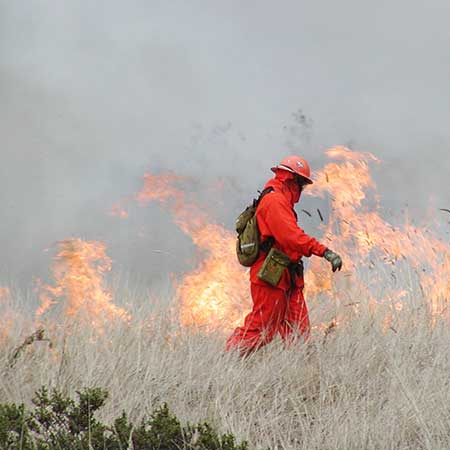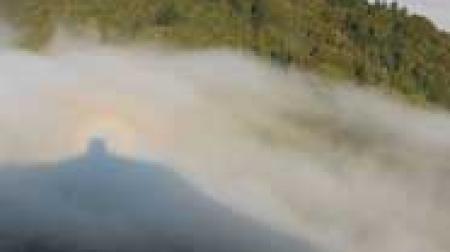Summary
European colonization, the removal of Coast Miwok people from their traditional lands, and the deliberate curtailing of the use of fire for Tribal land stewardship have dramatically altered the region’s natural fire regimes. This has been compounded by modern fire suppression efforts that began in the 1930s (GGNPC 2023b; Nelson, 2023). Consequently, it has been more than 70 years since Mt. Tam experienced a large, stand-replacing fire. Excluding fire has had significant negative impacts to the mountain’s cultural and natural resources, and it is important to work toward increased collaboration with Tribal representatives to plan and implement prescribed burns informed by Traditional Ecological Knowledge (Nelson, 2023).
While fire suppression is important to protect local air quality and nearby property, plant communities on Mt. Tam are naturally dynamic and largely mediated by fire cycles (LCA, 2009). The elimination of fire has resulted, in part, in the succession of grasslands to shrublands, shrublands to woodlands, and woodlands dominated by Douglas-fir (Pseudotsuga menziesii). Fire suppression also has implications for the regeneration of fire-dependent species such as Sargent cypress (Cupressus sargentii) and Marin manzanita (Arctostaphylos virgata). There are many questions about how the seed banks of these and other fire-dependent species will respond to future fires—or the lack thereof—on Mt. Tam. More detail on the effects a lack of fire is having on these communities may be found in these Peak Health pages (and in the report at left).
In addition to these direct impacts, changed fire regimes and fire suppression are interacting with other ecological stressors on Mt. Tam in a variety of ways. Increased fuel loads caused by forests impacted by Sudden Oak Death may in turn increase the intensity of any fires that do occur. Large fires burn hotly and can kill significant numbers of trees over a wide area. This both releases nutrients into the soil and increases the amount of light reaching the ground, which can be exploited by non-native, invasive plants (LCA, 2009). On Mt. Tam, climate change is expected to increase fire frequencies on the order of 20% under projected climate scenarios (Micheli et al., 2016). However, underlying factors can combine in ways that make specific effects difficult to predict. In general, drier and warmer conditions are more favorable to wildfires. At present, state-wide fire management policies require suppression of all unplanned wildland fires. In Marin County, the number of wildland fires—both accidentally and deliberately ignited—has trended upward over the last several decades, but the total area burned per decade has declined (CDFFP, 2015). This is largely due to more-effective fire suppression efforts. So, while models predict more intense fires, current suppression policies continue to maintain the fire regime in an altered state. This will likely lead to infrequent, but large and intense, wildland fires that will burn many acres despite efforts to control them.
Learn More
Fire's role in the region is explored extensively in the 2023 Marin Regional Forest Health Strategy, which stemmed from and now informs One Tam's Peak Health effort. The One Tam partners developed this strategy to improve and maintain the natural resilience of forests and woodlands in the face of stressors such as plant disease, introduced weeds, present and past land-use, the legacy of colonization, climate change, and hazardous wildfire. We worked with the Federated Indians of Graton Rancheria, fire agencies, scientists, and consultants to study the current condition of our forests, threats to their health, and how we can prioritize collaborative action. Visit our forest health page to view the strategy and related resources and activities.
One Tam partners are also working to return fire to these landscapes where appropriate. Get your questions about prescribed fire answered here.
resources
California Department of Forestry and Fire Protection [CDFFP]. (2015). Fire history: Spatial database [Data file]. https://frap.fire.ca.gov/mapping/gis-data/
Golden Gate National Parks Conservancy [GGNPCa]. (2023). Marin regional forest health strategy. Tamalpais Lands Collaborative (One Tam). https://www.onetam.org/forest-health
Leonard Charles Associates. (2009). Biodiversity Management plan for Marin Municipal Water District Lands. Retrieved from: http://www.marinwater.org/documentcenter/view/233.
Micheli, E., Flint, L., Veloz, S., Johnson (Higgason), K., & Heller, N. (2016). Climate Ready North Bay Vulnerability Assessment Data Products: 2. Marin Municipal Water District User Group. A technical memorandum prepared by the Dwight Center for Conservation Science at Pepperwood, Santa Rosa, CA, for the California Coastal Conservancy and Regional Climate Protection Authority. Available from http://climate.calcommons.org/crnb/mmwd.
Nelson, P. A. and Golden Gate National Parks Conservancy [GGNPC] (2023). Chapter 3: Tribal Stewardship & Partnership. In Marin Regional Forest Health Strategy (pp. 63-90). Tamalpais Lands Collaborative (One Tam). https://www.onetam.org/forest-health



